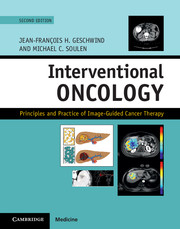Book contents
- Frontmatter
- Contents
- List of contributors
- Section I Principles of oncology
- Section II Principles of image-guided therapies
- Section III Organ-specific cancers – primary liver cancers
- 10 Assessment and triage of hepatocellular carcinoma
- 11 Image-guided ablation of hepatocellular carcinoma
- 12 Embolization of liver tumors: Anatomy
- 13 Conventional chemoembolization and chemoembolization with drug-eluting beads: Technique and future potential
- 14 90Yttrium radioembolization for hepatocellular carcinoma
- 15 Image-guided therapy of intrahepatic cholangiocarcinoma
- Section IV Organ-specific cancers – liver metastases
- Section V Organ-specific cancers – extrahepatic biliary cancer
- Section VI Organ-specific cancers – renal cell carcinoma
- Section VII Organ-specific cancers – chest
- Section VIII Organ-specific cancers – musculoskeletal
- Section IX Organ-specific cancers – prostate
- Section X Specialized interventional techniques in cancer care
- Index
- References
15 - Image-guided therapy of intrahepatic cholangiocarcinoma
from Section III - Organ-specific cancers – primary liver cancers
Published online by Cambridge University Press: 05 September 2016
- Frontmatter
- Contents
- List of contributors
- Section I Principles of oncology
- Section II Principles of image-guided therapies
- Section III Organ-specific cancers – primary liver cancers
- 10 Assessment and triage of hepatocellular carcinoma
- 11 Image-guided ablation of hepatocellular carcinoma
- 12 Embolization of liver tumors: Anatomy
- 13 Conventional chemoembolization and chemoembolization with drug-eluting beads: Technique and future potential
- 14 90Yttrium radioembolization for hepatocellular carcinoma
- 15 Image-guided therapy of intrahepatic cholangiocarcinoma
- Section IV Organ-specific cancers – liver metastases
- Section V Organ-specific cancers – extrahepatic biliary cancer
- Section VI Organ-specific cancers – renal cell carcinoma
- Section VII Organ-specific cancers – chest
- Section VIII Organ-specific cancers – musculoskeletal
- Section IX Organ-specific cancers – prostate
- Section X Specialized interventional techniques in cancer care
- Index
- References
Summary
Our understanding and management of intrahepatic cholangiocarcinoma have evolved substantially over the past 5 years, leading to a new staging system distinct from that used for primary hepatocellular carcinoma (HCC), and identification of prognostic imaging and histologic phenotypes which provide more sophisticated guidance for triage.
While primary liver cancer is recognized as among the most deadly malignancies on the planet, approximately 10% of primary hepatobiliary tumors are cholangiocarcinomas. Ninety percent of these originate in the extrahepatic ducts, leaving about 10% as intrahepatic cholangiocarcinomas. These relatively rare tumors account for less than 10,000 new cancers in the USA annually and about 3% of gastrointestinal cancers worldwide. The incidence appears to be increasing globally; however, this is associated with an improvement in immunohistochemical diagnosis, with more tumors previously categorized as adenocarcinoma of unknown primary now recognized as being of pancreaticobiliary origin, likely cholangiocarcinoma.
Unlike HCC, most patients with intrahepatic cholangiocarcinoma have no known risk factors. Recognized risks include conditions associated with chronic inflammation or infection of the biliary tree, such as sclerosing cholangitis, choledochal cyst, biliary cirrhosis, parasitic infections, and hepatic cirrhosis. However, 90% of patients lack any predisposing condition, so routine surveillance is the exception and diagnosis is often delayed until symptoms develop in advanced stages. Early lymphatic spread, bone metastases, and intrahepatic liver metastases are more common than in HCC. Macrovascular invasion is seen similarly to HCC.
Diagnosis of intrahepatic cholangiocarcinoma can be challenging. Imaging appearance is variable, with three imaging phenotypes described as mass-forming, infiltrative, and intraductal invasion. Tumor vascularity is highly variable, with late enhancement a distinguishing feature from HCC. Thorough diagnostic imaging and endoscopy are necessary to exclude other primaries. Biopsy diagnosis can be difficult due to desmoplastic stroma and poorly differentiated histology. Immunohistochemical stains can suggest a biliary origin, while negative stains help to exclude other tissues of origin such as primary liver or metastasis from pancreas, colon, breast, or lung cancer. Tumor markers can be helpful to distinguish cholangiocarcinoma from HCC. A CA-19-9 level > 100 U/mL (normal up to 37 U/mL) is 68% sensitive and 96% specific for intrahepatic cholangiocarcinoma in patients without sclerosing cholangitis. Less-specific tumor marker elevations include carcinoembryonic antigen, CA-125, and alpha-fetoprotein, with 10% having a mixed hepatocholangiocarcinoma histology.
Information
- Type
- Chapter
- Information
- Interventional OncologyPrinciples and Practice of Image-Guided Cancer Therapy, pp. 134 - 138Publisher: Cambridge University PressPrint publication year: 2016
